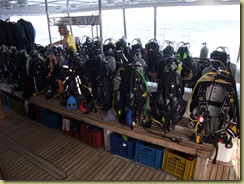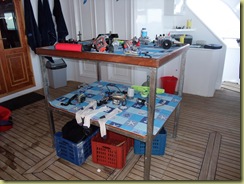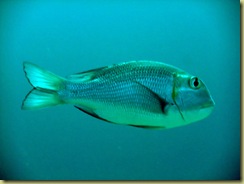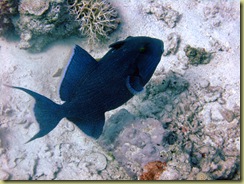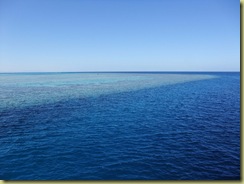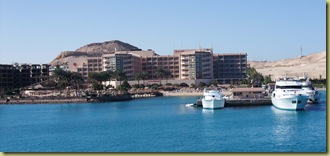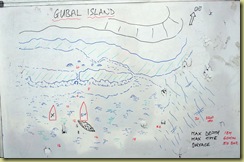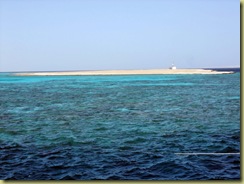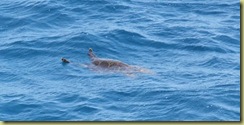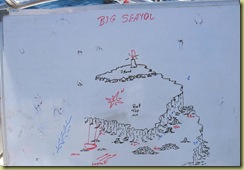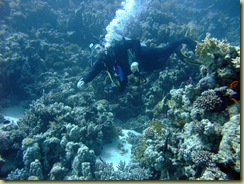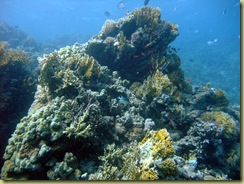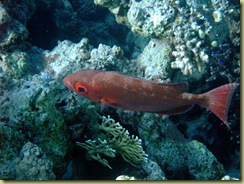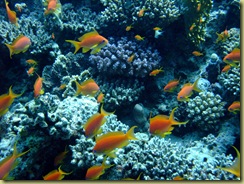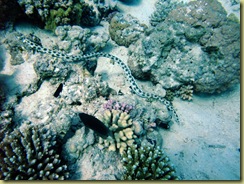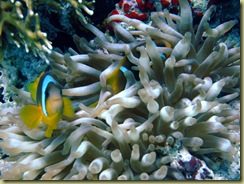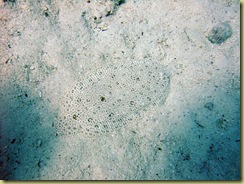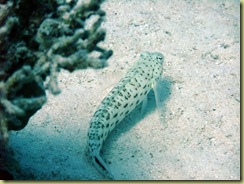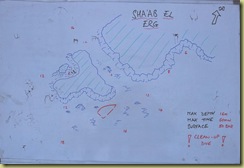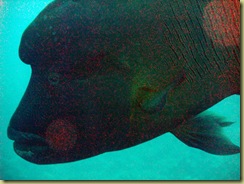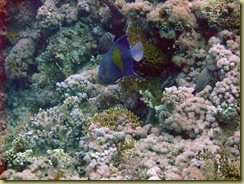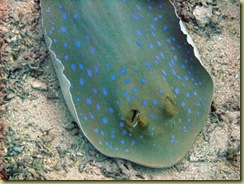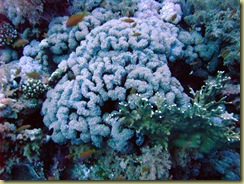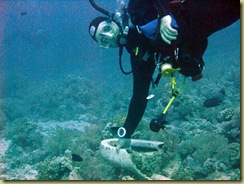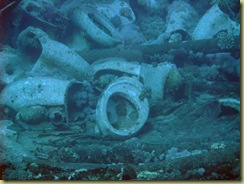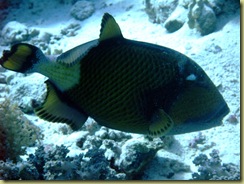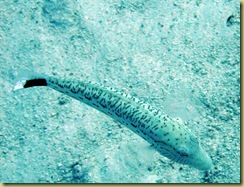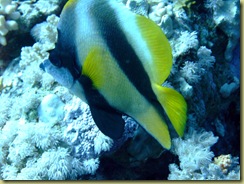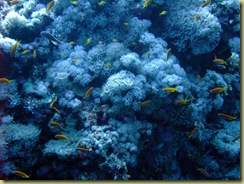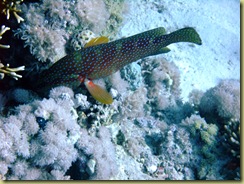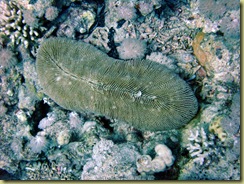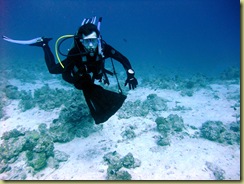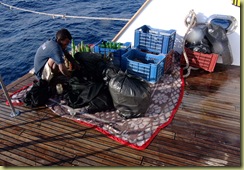Day 5 Tuesday February 10th
Diving is an activity which, if done according to the rules, is always done with a buddy, i.e. you always dive with someone else and you take care of each other during the dive. This care starts with the pre-dive buddy check. For us, if we used all of our equipment, getting dressed for diving usually involves putting on: trunks; rash vest (or equivalent); wet suit; hood; dive socks; weights; buoyancy control device (bcd) with attached tank; mask and snorkel; fins; gloves; dive knife; dive computer; camera; surface marker buoy; dive slate; regulator and octopus. Although the total weight of all of the above is in excess of 25 kg, as soon as you get into the water you are virtually weightless.
Having got your equipment on, you then proceed to the important “buddy check” where you check that your buddies equipment is being correctly worn and works in the order: BCD; weights; regulator; air; and final check. Since you will depend on your buddies air supply if yours goes wrong, it is advisable to check properly and carefully. Also if any part of your equipment goes wrong during a dive, you may land up depending on some other item to keep you safe – so a wise diver checks his own equipment carefully.
Once in the water, you constantly communicate with each other via a sign language which consists of certain common codes (which can be understood by any diver) plus your own dialect variants. The whole of this was to prove valuable to us today.
Dive 11 – Thistlegorm (lat 27.81268 long 33.9194)
The Thistlegorm is dived by most divers when they visit the Northern Red Sea. It can be a challenging but straightforward dive, it can also be a challenging and difficult dive. There is much on the web about the Thistlegorm so I will not repeat this information here – if you are interested just click on the ship name above and you will be taken to another web site with detailed information.
In summary, it is a freighter which was sunk by German bombers during the second world war whilst fully laden. During the dive you get the chance to go into the holds and see much of the cargo. the bomb damage area, accommodation etc. We both dived the wreck last year when there was a strong current and visibility was not very good.
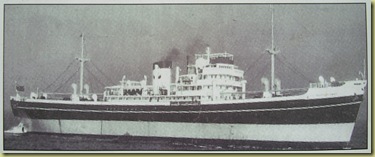
For this dive, the plan was to descend down a line tied to the bow, fin along the starboard side exploring Holds one and two, then back up the port side to the bow line and ascend.
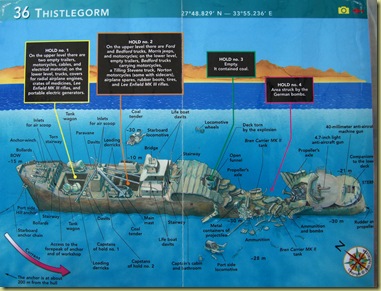
Because the dive was difficult last time (strong current and poor visibility) and it is also a more complex wreck penetration dive, we asked for a dive guide to go with us.
Three other dive boats were tied to the Thistlegorm when we arrived, our boat tied of to the bow of the wreck (by sending down a diver with the rope) and then because there was a heavy swell of about 4 metres (not ideal diving conditions), three more ropes were attached. We suited up, Ben and the Dive Guide jumped into the water and just as I was about to follow them, three of the four mooring ropes snapped and I was stopped from going in whilst the ship repositioned. Ben immediately swapped buddies to the Dive Guide and followed standard procedures for hanging around in rough water – inflate your BCD, stay calm and stay with your buddy. There were also other ships near by which they could have gone to if things got difficult.
Eventually I was put into a rib and driven over to them and we dived (as a threesome) down through the swell (which was now even heavier) to the bow. Visibility down on the wreck was very good and we had an excellent dive through the holds and saw many things we had not been able to see last time including the railway engines.


On the way back up, the dive got a more difficult because the mooring line up which were were supposed to ascend was jerking a lot indicating that it was quite rough on the surface. The line managed to knock one of the weights out of my BCD but luckily I was holding on to the line at the time so I did not shoot up and Ben ascended with the weight in his arms for me to reaffix. Once on the surface, it was a matter of inflating our BCDs as fully as possible and putting up a Surface Marker Buoy to indicate our position and then awaiting the arrival of a Rib to take us back to the Blue Melody.
It was a great dive but it was marred by the surface conditions. Thankfully the planned second dive on the Thistlegorm was cancelled and we sailed off to quieter waters. We both felt that our decision to ask for a Dive Guide was absolutely correct in the circumstances although our training had covered all that we did during the dive.
Dive 12 was on The Barge (lat 27.67792 long 33.80543) and the lagoon area nearby.
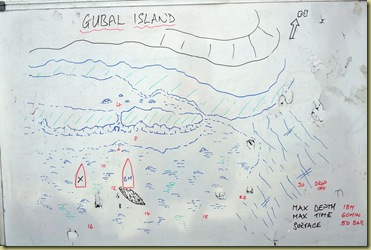
The barge is located on the south side of Big Gubal Island and is a well known dive spot. We both dived it last year and were amazed at the variety of fish and the large Moray Eel (George). Rumour was that George had now been joined by Georgina.
The dive plan was to descend to the barge, have a look around it and then proceed north, go across a lowering of the reef wall and into the lagoon.
The dive proceeded to plan although the current was slightly stronger than estimated by the dive guide – this was said to be due to the fact that it was a Full Moon.
There is not much left of the barge now and 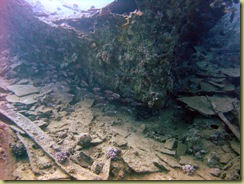
no-one knows of its history. Large shoals of
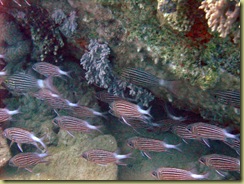
Crown Squirrelfish shelter against its walls although they are then prey to the many Lion fish who live in the
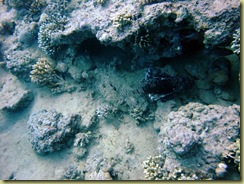
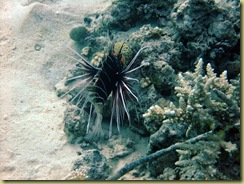
area. Georgina was hiding against the wall of
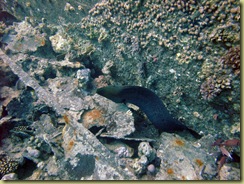
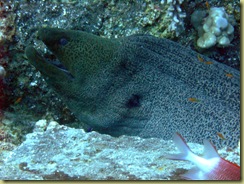
the barge. Particularly nice was the return from the lagoon through the gap because the

current was flowing out of the lagoon through the gap and it swept you past some very
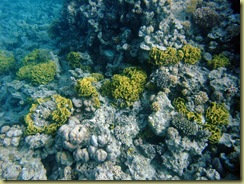
nice coral and towards shoals of Scissor Tail Sergent Fish.
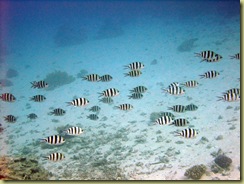
Dive 13 was planned to be “The barge by night”. Quite simple - off the back of the boat, head to the barge, around the barge a few times, look out for George (and even more Lion Fish), back to the boat, a quick shower and then dinner and a well deserved beer. The only thing we were warned to watch out for was that the current was said to be “a little stronger and running from the barge towards the boat”.
As soon as we got into the water it was obvious that the current estimate was well short of the mark. One had to fin very hard to make any progress against it and by the time we got to the barge I was worn out. We rested by holding onto the barge and floated in the current and then called off the dive (through sign language) and with a few current driven detours, headed back to the boat platform and the line hanging off the back to do our safety stop. Unfortunately we missed the line and then had to fin very very hard against the current to get to the line. By the time we were on deck I was exhausted, as were most of the other divers who went in at the same time as us. The general conclusion was that the current was increasing in strength all of the time we were in the water because of the moon.

